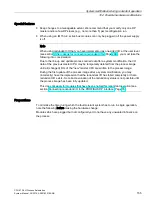
Special functions of the CPU 410-5H
9.9 Time synchronization
CPU 410-5H Process Automation
System Manual, 09/2014, A5E31622160-AB
149
9.9
Time synchronization
Introduction
The CPU 410-5H has a powerful timer system. You can synchronize this timer system using
a higher-level time generator, which will allow you to synchronize, trace, record, and archive
sequences.
Interfaces
Time synchronization is possible via every interface of the CPU 410-5H:
●
PROFIBUS DP interface
You can configure the CPU as a time master or a time slave.
●
PROFINET IO interface via Industrial Ethernet
Time synchronization using the NTP method; the CPU is the client.
Time synchronization using the SIMATIC method as master or slave
●
Within the station (in the AS) by means of the S7-400 backplane bus
You can configure the CPU as a time master or a time slave.
Time synchronization via the PROFINET IO interface
With the PROFINET IO interface, time synchronization is possible using the NTP method
and the SIMATIC method. The PROFINET IO CPU is a client in this process.
You may configure up to four NTP servers. You can set the update interval between 10
seconds and 1 day. For times greater than 90 minutes, an NTP request of the PROFINET IO
CPU always occurs every 90 minutes.
If you synchronize the PROFINET IO CPU in the NTP method, you should use SICLOCK or
an NTP server on the OS.
Time synchronization is also possible via Ethernet MMS (Simatic method on Ethernet) as
master or slave. The combination NTP with SIMATIC method is allowed in this case.
CPU as a time slave
If the CPU is a time slave on the S7-400 backplane bus, synchronization is carried out via
the CP by a central clock connected to the LAN.
You can use a CP to forward the time to the S7-400 station. If the CP supports a direction
filter, the CP must be configured for time forwarding with the "from LAN to station" option.
















































